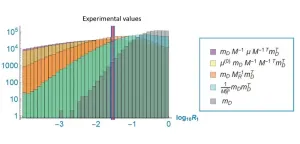(Press-News.org) Bottom Line: Pancreatic intraepithelial neoplasia (PanIN) lesions were detected in a majority of healthy pancreata from deceased donors of diverse age and harbored features of pancreatic cancer.
Journal in Which the Study was Published: Cancer Discovery, a journal of the American Association for Cancer Research
Authors: Marina Pasca di Magliano, PhD, co-corresponding author of the study, a researcher at the Rogel Cancer Center, and a professor of surgery and of cell and developmental biology at Michigan Medicine at the University of Michigan
Timothy Frankel, MD, co-corresponding author, a researcher at the Rogel Cancer Center, and an associate professor and surgical oncologist at Michigan Medicine at the University of Michigan
Eileen Carpenter, MD, PhD, first author, a researcher at the Rogel Cancer Center, and a gastroenterologist and assistant professor at Michigan Medicine at the University of Michigan
Background: Pancreatic cancer is a rare but highly fatal disease, with a five-year relative survival rate of 11.5%. With few early symptoms, it is typically diagnosed at advanced stages when it is more difficult to treat. Pancreatic cancer may be preceded by several precancer lesions, including PanINs, intraductal papillary mucinous neoplasms, and mucinous cystic neoplasms.
“Understanding how pancreatic tissue evolves as it transitions from normal to precancerous to cancerous will be key to identifying strategies for early detection, prevention, and treatment of pancreatic cancer,” said Pasca di Magliano. “Unfortunately, it has been difficult to understand the baseline characteristics of the pancreas due to a lack of normal pancreatic tissue available for research.”
“Since there is no reason to biopsy or resect a physiologically normal pancreas, researchers have had to rely on the tissue surrounding pancreatic tumors as the so-called normal,” explained Frankel. “However, it is clear that the tissue adjacent to tumors is very abnormal looking and is not a reliable surrogate for true, healthy pancreatic tissue.”
How the Study was Conducted: To characterize normal pancreatic tissue, the authors partnered with Gift of Life Michigan to obtain healthy pancreata from 30 recently deceased donors for whom no suitable transplant recipients were identified. Because the pancreata were donated following brain death, blood flow was maintained until the organ could be resected and immediately cooled, which limited warm ischemic time and helped preserve the cellular and transcriptomic profile of the tissue.
Donors were between 20 and 70 years old at the time of death and did not have any pancreatic diseases. There were 20 male and 10 female donors. Approximately two-thirds of donors were white, approximately one-third were African American, one donor was Asian, and one donor was of unknown race.
Results: Using tissue collected from various regions of the pancreas, the researchers performed histopathologic analyses, which revealed the presence of PanINs in 18 of the 30 donor pancreata, representing all age and racial groups.
Analysis of the tissue immediately surrounding the PanIN lesions showed that the PanIN microenvironment was rich in fibroblasts, myeloid cells, and T cells, making it distinct from that of histologically normal pancreatic tissue.
To understand how the PanIN lesions of healthy donors compared with pancreatic tumors, the authors compared the microenvironment and gene expression of PanINs with previously published data of pancreatic cancer cells. They found that PanINs and pancreatic tumors had distinct microenvironments but similar gene expression patterns. Compared with the PanIN microenvironment, the tumor microenvironment had lower levels of acinar and endothelial cells and a greater proportion of macrophages and CD4+ T cells.
Author’s Comments: “By analyzing true normal pancreata, we found that PanINs were commonly found in individuals of diverse age and race, and may have already acquired some features of malignant cells,” summarized Carpenter. “Given that pancreatic cancer is exceedingly rare, the widespread occurrence of PanINs in individuals of various age and race challenges the paradigm that PanINs always evolve into cancer.”
“Prior efforts at early detection have focused on finding the PanIN lesions, with the assumption that individuals with PanINs would be the ones at risk of developing pancreatic cancer, but our findings suggest that additional factors are involved,” said Frankel.
“Understanding why some PanINs evolve to cancer and others do not will be important to accurately predict who is at risk of pancreatic cancer and to develop techniques for cancer interception,” Pasca di Magliano said. “The composition of the microenvironments surrounding PanINs might be a key factor.”
Study Limitations: A limitation of the study was the inability to observe changes in the pancreas over time or to examine the impact of therapeutic interventions, the authors noted. “The tissue we examined provided only a snapshot of the pancreas at the time of the donor’s death,” said Pasca di Magliano. An additional limitation was the small sample size.
Funding & Disclosures: The study was supported by the National Institutes of Health, the Veterans Affairs Biomedical Laboratory and Research Development Awards, the American College of Gastroenterology, the Rackham International Student Fellowship, the CCSG Bioinformatics Shared Resource, the Association for Academic Surgery, and the Joel J. Roslyn Award. Pasca di Magliano, Frankel, and Carpenter declare no conflicts of interest.
END
Pancreatic lesions may occur more frequently than previously thought
Researchers partnered with Gift of Life Michigan to analyze healthy pancreata from deceased donors
2023-04-06
ELSE PRESS RELEASES FROM THIS DATE:
People with obesity due to genetic predisposition have lower risk of cardiovascular disease
2023-04-06
The risk of developing cardiovascular disease is lower in people with obesity who have a genetic predisposition for high BMI than people with obesity influenced mainly by environmental factors such as lifestyle, researchers from Karolinska Institutet report in eClinicalMedicine.
There has been a global increase in the incidence of overweight and obesity over the past few years. Almost one third of the world’s population now lives with overweight or obesity.
“The figure is alarming since it is well-established that a high BMI in middle-age increases the risk of developing ...
Obstructive sleep apnea may directly cause early cognitive decline
2023-04-06
Obstructive sleep apnea (OSA) is a potentially dangerous condition. During sleep, the throat muscles of people with OSA relax and block the airflow into the lungs, so that they repeatedly stop breathing. Common symptoms of OSA include restless sleep, loud snoring, daytime sleepiness, and prolonged headaches in the morning – highly debilitating for patients and their partners.
OSA is currently underdiagnosed: it may occur in as much as 15 to 30% of men and 10 to 15% of women, or approximately 1bn adults worldwide, of whom an estimated 80% don’t know they have it. Major risk factors for OSA include middle or old age, being obese, smoking, ...
Random matrix theory approaches the mystery of the neutrino mass!
2023-04-06
When any matter is divided into smaller and smaller pieces, eventually all you are left with—when it cannot be divided any further—is a particle. Currently, there are 12 different known elementary particles, which in turn are made up of quarks and leptons each of which come in six different flavors. These flavors are grouped into three generations—each with one charged and one neutral lepton—to form different particles, including the electron, muon, and tau neutrinos. In the Standard Model, the masses of the three generations of neutrinos are represented by a three-by-three ...
Lab-grown fat could give cultured meat real flavor and texture
2023-04-06
Researchers at Tufts University have successfully bulk-produced fat tissue in the lab that has a similar texture and make-up to fat tissue naturally occurring in animals. The results, described in a study published today in eLife, could be applied to the production of cultured meat grown entirely from cells, giving it a more realistic texture and flavor.
Startup companies around the world are developing cultivated meat—cell-grown chicken, beef, pork, and fish. Most are in early stages of development, not ready for large-scale production and, with a ...
Disruption from war in Ukraine pushes highly contagious infectious diseases to alarming levels
2023-04-06
Analysis of official Ukraine health data reveals a perfect storm of rising infectious diseases cases and falling levels of childhood vaccination and case detection in the frontline eastern region of Kharkiv.
Between January and September 2022, new cases of rubella were 23 times higher among children living in the Kharkiv region than average rates across Ukraine, while shigellosis (diarrhoeal disease) and viral meningitis incidence was around 6 times higher, and whooping cough 5 times greater.
But registration of infectious disease cases halved in Kharkiv ...
Air pollution may increase risk for dementia
2023-04-06
Key points:
This meta-analysis, which includes the most recent studies evaluating the link between air pollution and dementia, is the first to include studies based on active case ascertainment and to evaluate studies using a new, more powerful bias assessment tool.
The findings support the public health importance of a proposal, currently under consideration by the Environmental Protection Agency, to strengthen regulations on PM2.5
Boston, MA—Exposure to fine particulate air pollutants (PM2.5) may increase the risk of developing dementia, according to a new meta-analysis from Harvard T.H. Chan School of Public Health.
“This is a big step in providing actionable ...
Exposure to fine particle air pollution linked to heightened dementia risk
2023-04-06
Exposure to fine particulate matter (PM2.5) air pollution is linked to a heightened risk of dementia, even at levels below current US, UK and European air quality standards, finds research published by The BMJ.
More limited data suggests that exposure to nitrogen dioxide and nitrogen oxide might also be a risk factor for dementia.
Many uncertainties remain, so caution is needed when interpreting these findings, but the researchers say the results “strengthen the evidence that air pollutants are risk factors for dementia.”
More than 57 million people worldwide are living with dementia and the global ...
Limit added sugar to six teaspoons a day to improve health, urge experts
2023-04-06
Experts recommend reducing consumption of added (“free”) sugars to around six teaspoons a day and limiting sugar-sweetened drinks to less than one serving a week after a comprehensive evidence review published by The BMJ today.
They found significant harmful associations between sugar consumption and 45 outcomes, including asthma, diabetes, obesity, heart disease, depression, some cancers and death.
It’s widely known that excessive sugar intake can have negative effects on health and this has prompted the World Health Organization (WHO) and others to suggest reducing consumption of free or added sugars ...
Healthy lifestyle associated with reduced mortality risk in childhood cancer survivors
2023-04-06
(MEMPHIS, Tenn. – April 05, 2023) A report from the Childhood Cancer Survivor Study (CCSS) provides strong evidence of the importance of a healthy lifestyle for adults who were treated for cancer as children. The study is the first to find that the specific primary causes of death in long term survivors are many of the same leading causes of death in the U.S. population, often occurring at younger than expected ages. It also found that adult survivors of childhood cancer experience four times the risk of late mortality as the general population, even 40 years after diagnosis. However, ...
Texas Children’s and Baylor College researchers use innovative dual-target deep brain stimulation approach to treat patients with obsessive-compulsive disorder and Tourette Syndrome
2023-04-06
Up to two-thirds of patients with Tourette syndrome (TS), a tic disorder characterized by sudden uncontrollable physical movements, also suffer from obsessive-compulsive disorder (OCD), a psychiatric condition characterized by intrusive thoughts and repetitive behaviors. Unfortunately, many of these dual-diagnosis patients are resistant to conventional treatments such as medications or behavioral therapy. While deep brain stimulation (DBS) has been approved for compassionate use by the U.S. Food and Drug Administration for OCD, this promising procedure is under investigational use for ...
LAST 30 PRESS RELEASES:
Structure of dopamine-releasing neurons relates to the type of circuits they form for smell-processing
Reducing social isolation protects the brain in later life
Keeping the heart healthy increases longevity even after cancer
Young adults commonly mix cannabis with nicotine and tobacco
Comprehensive review illuminates tau protein's dual nature in brain health, disease, and emerging psychiatric connections
Book prepares K-12 leaders for the next public health crisis
Storms in the Southern Ocean mitigates global warming
Seals on the move: Research reveals key data for offshore development and international ecology
Sports injuries sustained during your period might be more severe
World's first successful 2 Tbit/s free-space optical communication using small optical terminals mountable on satellites and HAPS
Can intimate relationships affect your heart? New study says ‘yes’
Scalable and healable gradient textiles for multi‑scenario radiative cooling via bicomponent blow spinning
Research shows informed traders never let a good climate crisis go to waste
Intelligent XGBoost framework enhances asphalt pavement skid resistance assessment
Dual-function biomaterials for postoperative osteosarcoma: Tumor suppression and bone regeneration
New framework reveals where transport emissions concentrate in Singapore
NTP-enhanced lattice oxygen activation in Ce-Co catalysts for low-temperature soot combustion
Synergistic interface engineering in Cu-Zn-Ce catalysts for efficient CO2 hydrogenation to methanol
COVID-19 leaves a lasting mark on the human brain
Scientists use ultrasound to soften and treat cancer tumors without damaging healthy tissue
Community swimming program for Black youth boosts skills, sense of belonging, study finds
Specific depressive symptoms in midlife linked to increased dementia risk
An ‘illuminating’ design sheds light on cholesterol
Who is more likely to get long COVID?
Study showcases resilience and rapid growth of “living rocks”
Naval Research Lab diver earns Office of Naval Research 2025 Sailor of the Year
New Mayo-led study establishes practical definition for rapidly progressive dementia
Fossil fuel industry’s “climate false solutions” reinforce its power and aggravate environmental injustice
Researchers reveal bias in a widely used measure of algorithm performance
Alcohol causes cancer. A study from IOCB Prague confirms damage to DNA and shows how cells defend against it
[Press-News.org] Pancreatic lesions may occur more frequently than previously thoughtResearchers partnered with Gift of Life Michigan to analyze healthy pancreata from deceased donors


